
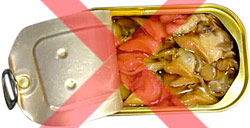 |
| No canned clams for Primo |
Primo’s ultimate litmus test when visiting a new Italian restaurant is to ask the waiter how they prepare “Linguine with White Clam Sauce”.
Do they use fresh clams?
Usually the waiter will answer, “Yes...we put a few fresh ones in the sauce”; which translates as a code to Primo that they’re using canned clams and bottled clam juice, a crime against all of the laws of love and nature; they are serving a dish prepared by Philistines.
Pops will politely thank the waiter, and move on to another menu item.
Linguine With White Clam Sauce is the ultimate Italian “Zen” dish. The list of ingredients is deceptively simple.
It takes a meditative discipline to prep and prepare. It’s very labor intensive, but great things come to those who have patience. There’s a lot of kitchen foreplay involved. The spirits of Cupid and Venus enter the kitchen space; you really have to love who you’re feeding to scrub and shuck approximately 60 clams to get to the assembly stage.
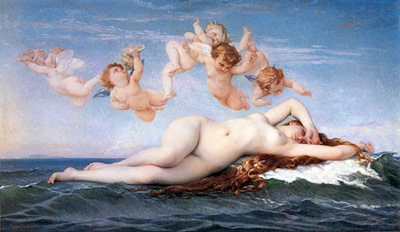 |
| "The Birth of Venus" by Alexandre Cabanel |
Properly prepared, its heady aroma and aphrodisiacal power cannot be understated. The cradle of all creation, the sea, opens up in your mind’s eye upon sampling your first forkful.
The Goddess Salacia whispers softly in your left ear whilst her husband King Neptune whispers in the other. This is the dish of human history, and you taste it right down to the primordial single-celled ooze from which you came, not just your taste buds. You automatically de-construct to your former molluskular level, and then re-combine enlightened. It's a full body experience.
I have witnessed grown men... strangers, in fact, at Primo’s dinner table break down and weep as they partake in this delicate dish as he prepares it. It will take you to the farthest reaches of the infinite Universe and back within a nanosecond.
It’s that mind-blowingly good.
Ingredients
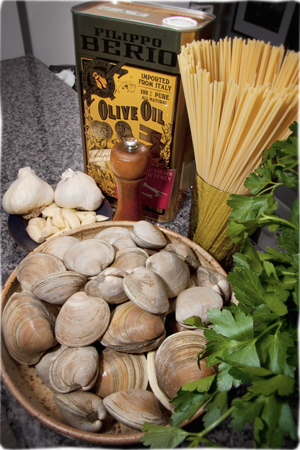
One batch feeds four guests extremely well.
1 lb of Imported Linguine or Linguine Fini Pasta made with 100% Durum Semolina
32 Fresh Little Neck Clams
20 Fresh Cherry Stone Clams
1 Cup Fillipo Berio “Gold Label” medium grade olive oil (approximately*)
5-15 Cloves of Fresh Garlic*
1 Bunch of Fresh Italian Flat Leaf Parsley, Finely Hand Chopped (about ½ -¾ ‘s of a cup*)
Freshly Ground Black Pepper
1 ½ tablespoons Coarse Ground Kosher Sea Salt for your pasta water
* A Little Note On Measurements
There are none! This is the original Rossi family dish that hinges on executing it by feel to a certain degree. There are no oil measurements. Its “cover the bottom of your pan with olive oil and then a little extra”, because Primo has been using the same pan for this sauce for over sixty years. He knows what works, and what doesn’t. You can ask “How much Garlic?” and he’ll answer “Five Cloves”...and then end up using closer to ten.You can ask “How much parsley?” and he’ll mumble, “Until it looks right”. Pretty vague instructions for a first timer. You can ask “How much pepper?” and he’ll shoot back, “Until it feels right and tastes good. Don’t be afraid of the Peppah, Pepster...it’s good for ya. Now GRIND!!!”
Which is his very unique way of telling me to not be afraid to spicing up my life as long as I’m not afraid of the work involved it takes to do it right. In other words, Spice it up all you want, but attach the right ethical values to “spice”. Spice is the work you do, what you produce and create, and the value you attach to it.
All I can say is that this is a dish that needs to be practiced and personalized, to your own kitchen tools and how you feel, most importantly. It’s ultimately needs to become your creation and vehicle for personal expression.
If you can’t make it with all of your heart, and be in touch with your soul as you make it... it just won’t come out right. As mentioned previously, this is a very Zen dish. It must be produced with a concentrated mindful awareness.
The Steps
The Prep Stage
Step #1 “SCRUBBA DA CLAMS”Have a tub filled with cold clear water in your sink that can hold all sixty or so clams. Under running water, scrub each clam (Primo rubs them with his bare hands) and place it in the tub.
Drain the water, remove the clams, and repeat this process two more times, at least! The goal is to remove every grain of sand that may be embedded within the grooves of the clam shell.
Every grain.
“Ya don’t wanna feed your family dirt!” Primo happily explains as he rubs along.
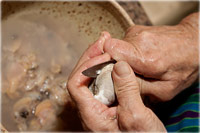 Step #2 “SHUCKA DA CLAMS”
Step #2 “SHUCKA DA CLAMS”
Here’s the “Primo Trick” that makes the preparation of the dish slightly less like performing a penance in a hair shirt while flogging yourself.
Put a thin coating of water on the bottom of a large diameter pan, and place a layer of clams on the surface. Over a high heat, bring the water up to a steam while flipping each clam.
With the benefit of a little heat and a little steam, those clam muscles will loosen ever so slightly. Primo uses a very sharp paring knife instead of a clam or oyster knife to shuck clams, because he wants to avoid a lot of shell breakage and grit.
They have to open just enough to slip the edge of the knife between the seal of bifurcated shell halves. You don’t want the clams to cook, and you don’t want to lose the juice. That’s the sauce!
When the clams are ready for shucking, immediately remove them from the pan. Over a bowl: Hold the clam in the cupped palm of your hand with the back end if the clam nestled in your palm. Split the clam and drive the knife edge through both muscles, harvest the juice, and scrape out the meat. Repeat this process for 52 clams.
The ratio of Little Neck to Cherry Stone clams is very important. The little necks deliver the delicate flavor and tender consistency, the Cherry Stones deliver the right volume of juice and their flavor and meat set the stage for the Little Necks to shine properly. If there is a strict measurement to follow, follow this one. Its been time tested for a few hundred years.
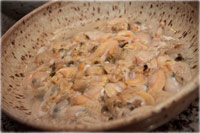 Step #3 “CHOPPA DA CLAMS”
Step #3 “CHOPPA DA CLAMS”
Grab a pair of scissors. Slice each clam in half, and set in a bowl, separating the meat from the juice. Do you want a more refined sauce? Slice the larger pieces twice instead of once.
Drain the juice in your “meat” bowl into your “juice” bowl. Carefully pour your juice into another bowl, leaving all the remaining bits of clam shell and sediment that settled to the bottom in the mother bowl behind. Discard the sediment.
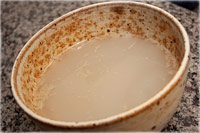 You’ll end up with a bowl of raw clam meat, and a bowl full of fresh clam juice. Now comes the fun part!
You’ll end up with a bowl of raw clam meat, and a bowl full of fresh clam juice. Now comes the fun part!
The Assembly Stage
- Pre warm your Pasta serving dish, and each individual serving plate in the oven at the lowest possible setting (115 degrees-145 degrees)
- Start boiling your pasta water.
- In a fairly large sauce pot, cover the surface area with olive oil, approximately one cup give or take a splash or two.
- Warm the oil slightly, and then cut the heat. Mince 5-10 cloves of garlic in the pot, and turn the heat back up to medium. Don’t burn the garlic! If it turns brown, chuck it and repeat this step.
- The garlic will start to bubble and separate. when it turns into a full blown flower, kind of looking like a bubbling chrysanthemum in the bottom of your pot, immediately add your clam juice, and turn your heat to high and bring to a boil. DO NOT STIR THE POT.
- Salt your now boiling pasta water half as much as you would normally (In Primo’s case, one handful instead of two. Roughly translated: one tablespoon instead of two!) Throw your pasta in the water, stirring constantly to “make sure your swimmers don’t stick together”.
In the sauce pot, a chemical reaction between the juice and the heat will occur. The broth will start to foam... again, don’t stir the pot. Let it get good and foamy as you bring that brew to a boil. - Toss in a good amount of parsley, and grind a copious amount of pepper into the pot. The foam will subside. NOW stir it all up, and remove from the heat. Start yelling at people to get to the table.
- Toss in all your clam meat, and cover the pot. By the time your pasta is cooked, the clams will have cooked to their absolute perfect moment. Cooked through, yet tender; plump, pink and juicy. You don’t want to overcook them and serve a sauce full of rubber dum dum bullets.
Cook your pasta to al dente status ( “to the tooth”), drain well, and dump it in your now warmed pasta serving dish. Slather a few cups of the actual clam sauce liquid without dumping too much of the meat onto the pasta and toss well.
For each plating, artfully toss a healthy amount of clam sauce and clam meat onto each serving, pour the remaining sauce into a gravy boat if anybody wants extra sauce (they will) and serve piping hot. Have some beautiful Italian bread on the side for mopping up purposes.
Sit down, and be prepared to be deified. You have just become the agent of Neptune to your now rapturous dinner guests.
This dish doesn’t need to be mucked up with additives like cheese, wine reductions, red pepper, lemon zest, butter or the latest chi-chi herb of the month. The secret of the sauce is its zen-like simplicity and purity.
If you see any of these items appear in a White Clam Sauce recipe, even from the so called food experts, make that your litmus test. If you think like Primo, you will think “Philistine”.... and then question everything they do from that point forward.
Buon Appetito!
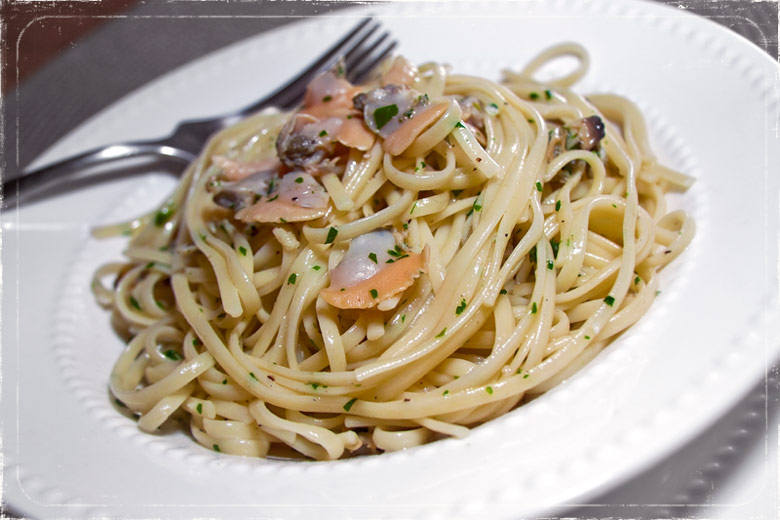
|
| The Laws of Love and Nature... All in a little Dish... HAAAA! |